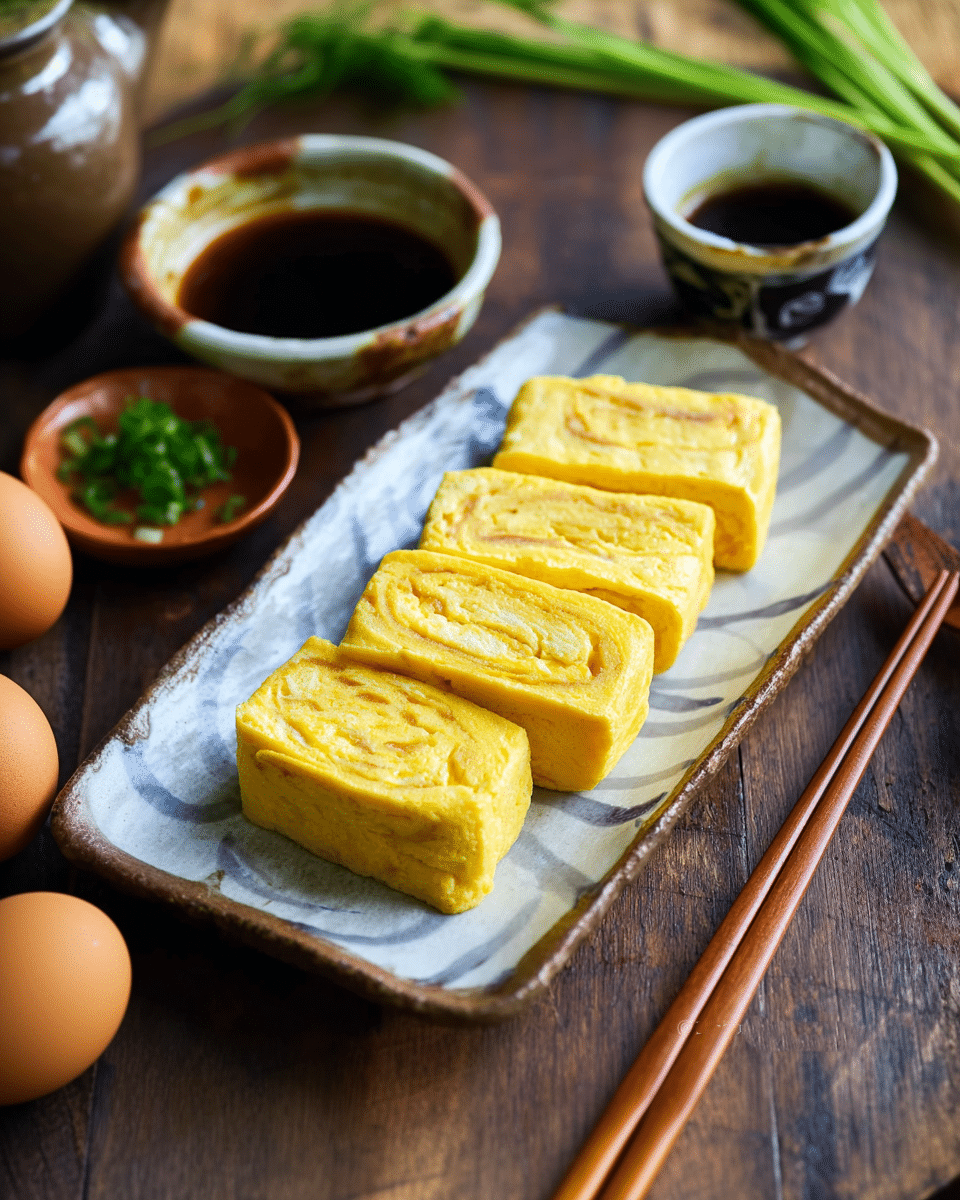Tamagoyaki is a traditional Japanese rolled omelette, famous for its fluffy, slightly sweet, and savory layers. This simple recipe requires just three ingredients: eggs, sugar, and soy sauce. It’s a great dish for breakfast or as part of a bento lunch. While tamagoyaki can be complex, this recipe makes it easy to prepare at home without needing dashi (Japanese soup stock). You can also experiment with variations and seasonings to suit your tastes!
Full Recipe:
Ingredients
-
3 large eggs (50g each, without shell)
-
½ tbsp sugar (adjust to taste, up to 1 tbsp for sweetness)
-
1 pinch kosher salt
-
1 tsp usukuchi (light-colored) soy sauce (or regular soy sauce)
-
1 tbsp water (optional, for fluffiness)
-
Neutral oil (for cooking)
Directions
-
Prepare the Egg Mixture:
In a bowl, combine eggs, sugar, salt, soy sauce, and water. Gently mix using a chopstick in a zigzag motion to avoid incorporating air into the eggs. If desired, strain the mixture through a fine mesh sieve for a smoother texture. -
Cook the Tamagoyaki:
Heat a tamagoyaki pan or a regular frying pan over medium heat. Lightly grease the pan with oil using a brush or paper towel. Test the pan’s heat with a drop of egg mixture—if it sizzles, it’s ready. -
Cook the First Layer:
Pour a thin layer of the egg mixture into the pan, tilting it to cover the surface evenly. Let it set, but leave the top soft and slightly runny. -
Roll the Omelette:
Once the first layer is set, roll the omelette from the far side of the pan toward the near edge. Push the rolled omelette to the far side of the pan. -
Repeat Layers:
Lightly grease the exposed area of the pan, pour in another layer of egg mixture, and tilt to cover. Once it sets, roll the omelette again. Repeat until the egg mixture is used up. -
Shape the Tamagoyaki:
After rolling all layers, press the omelette gently to shape it into a rectangular block. Let it rest for a few minutes to cool and set. -
Serve:
Slice the tamagoyaki into small pieces and serve, optionally with grated daikon and soy sauce.
Nutrients
-
Calories: 162 kcal
-
Carbohydrates: 4g
-
Protein: 10g
-
Fat: 12g
-
Saturated Fat: 3g
-
Cholesterol: 279mg
-
Sodium: 309mg
-
Potassium: 104mg
-
Sugar: 3g
-
Vitamin A: 405 IU
-
Calcium: 42mg
-
Iron: 1mg
Why You’ll Love Tamagoyaki
Tamagoyaki is a comforting and versatile dish. Its balance of sweet and savory flavors makes it a perfect way to start the day, and it’s equally satisfying as a lunch or snack. The beauty of tamagoyaki lies in its simplicity—the three primary ingredients are easy to find, and it doesn’t require complex techniques or tools.
Once you get the hang of the rolling process, tamagoyaki becomes a fun dish to prepare. The slight sweetness from the sugar, combined with the umami of the soy sauce, creates a harmonious flavor that’s both comforting and satisfying. Whether you serve it as a stand-alone dish or incorporate it into a larger meal, tamagoyaki offers a delightful addition to any menu.
The Ingredients That Make Tamagoyaki Special
-
Eggs: Eggs are the base of tamagoyaki, and they provide the fluffy texture that makes this dish so unique. They are rich in protein and healthy fats, making tamagoyaki a nutritious choice for breakfast or lunch.
-
Sugar: A small amount of sugar is added to balance the savory flavors and give tamagoyaki its characteristic sweetness. You can adjust the sugar to your taste, adding more if you prefer a sweeter omelette.
-
Soy Sauce: Usukuchi soy sauce (light-colored soy sauce) gives tamagoyaki a subtle umami flavor without overpowering the dish. Regular soy sauce can also be used.
-
Salt: A pinch of salt enhances the overall flavor of the tamagoyaki, bringing out the sweetness and savory elements.
-
Water: Adding water helps make the egg mixture more tender and fluffy. This is optional, but it can give the omelette a lighter texture.
-
Neutral Oil: A neutral oil, such as vegetable oil, is used for cooking and ensures the omelette doesn’t stick to the pan.
How to Make Tamagoyaki
Making tamagoyaki is a simple process, but it requires some patience to create those beautiful, layered rolls. Here’s how to make it:
1. Prepare the Egg Mixture
-
In a bowl, combine the eggs, sugar, salt, soy sauce, and water (if using). Use a chopstick or fork to gently mix the ingredients in a zigzag motion. Be careful not to incorporate too much air into the eggs, as this can affect the texture.
-
If you prefer a smoother texture, you can strain the mixture through a fine mesh sieve to remove any air bubbles or impurities.
2. Heat the Pan
-
Heat a tamagoyaki pan or a regular frying pan over medium heat. Lightly grease the pan with oil using a brush or a paper towel.
-
To test if the pan is ready, drop a small amount of egg mixture into the pan. If it sizzles, the pan is hot enough.
3. Cook the First Layer
-
Pour a thin layer of the egg mixture into the pan, tilting the pan to spread it evenly over the surface.
-
Let the egg cook for a short time, but leave the top slightly runny. Once it sets but is still slightly soft on top, you can start rolling.
4. Roll the Omelette
-
Once the first layer has set, carefully roll the omelette from the far side of the pan towards the near edge.
-
Push the rolled omelette to the far side of the pan.
5. Repeat Layers
-
Lightly grease the exposed area of the pan and pour in another thin layer of egg mixture. Tilt the pan again to spread the egg evenly.
-
Let the egg set, then roll it over the previous roll. Repeat this process until all the egg mixture has been used up.
6. Shape the Tamagoyaki
-
After rolling all the layers, gently press the tamagoyaki to shape it into a rectangular block. Let it rest in the pan for a few minutes to cool slightly and set its shape.
7. Serve
-
Once the tamagoyaki has cooled enough to handle, slice it into small pieces and serve. Optionally, serve with grated daikon and a small drizzle of soy sauce for extra flavor.
Nutritional Benefits of Tamagoyaki
Tamagoyaki is not only delicious but also provides a good balance of essential nutrients. Here’s a breakdown of the key nutrients:
-
Calories: Each serving contains approximately 162 calories, making it a moderate-calorie dish that’s satisfying without being heavy.
-
Protein: With 10 grams of protein per serving, tamagoyaki provides a good source of high-quality protein, which is essential for muscle growth and repair.
-
Fat: The dish contains 12 grams of fat, including 3 grams of saturated fat. The fat comes from the eggs and the small amount of oil used for cooking.
-
Carbohydrates: Each serving contains 4 grams of carbohydrates, mainly from the sugar and small amounts of starch in the eggs.
-
Cholesterol: With 279 mg of cholesterol per serving, tamagoyaki has a moderate amount of cholesterol due to the eggs. If you want to lower the cholesterol content, you could reduce the number of egg yolks.
-
Sodium: The sodium content is 309 mg per serving, mainly from the soy sauce. You can use a low-sodium soy sauce to reduce the sodium levels.
-
Fiber: Tamagoyaki contains 1 gram of fiber, mainly from the small amount of vegetables in the dish (if added).
-
Sugar: The sugar content is 3 grams per serving, providing a mild sweetness that balances the savory flavors of the soy sauce.
Serving Suggestions
Tamagoyaki is incredibly versatile and can be served in various ways:
-
For Breakfast: Serve tamagoyaki with a side of steamed rice and miso soup for a traditional Japanese breakfast.
-
For Bento: Tamagoyaki is a popular addition to Japanese bento lunch boxes. Pair it with other small dishes like pickled vegetables, rice, and grilled fish for a well-balanced lunch.
-
As a Snack: Tamagoyaki makes for a tasty snack, served with a side of soy sauce or pickled ginger for extra flavor.
-
With Sides: Serve tamagoyaki with a light salad, sautéed vegetables, or noodles for a complete meal.
Conclusion
Tamagoyaki is a delicious and versatile dish that’s easy to make and full of flavor. Whether you enjoy it for breakfast, lunch, or as part of a bento, this simple rolled omelette brings a delightful mix of savory and sweet flavors. With just a few ingredients and minimal effort, tamagoyaki can become a regular part of your meal rotation. Try it today and enjoy the fluffy, tender layers of this classic Japanese dish!






